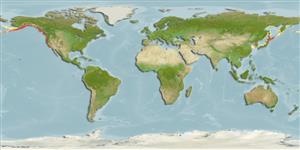Common names from other countries
>
Perciformes/Cottoidei (Sculpins) >
Rhamphocottidae (Grunt sculpins)
Etymology: Rhamphocottus: Greek, rhamphos = bill, peak + Greek, kottos = a fish without identificaction (Ref. 45335); richardsonii: Named after John Richardson, naturalist and explorer (Ref. 6885).
More on author: Günther.
Environment: milieu / climate zone / depth range / distribution range
Ökologie
seewasser demersal; tiefenbereich 0 - 165 m (Ref. 2850). Temperate; 66°N - 32°N
North Pacific: Japan to Alaska and at least Santa Monica Bay, southern California, USA.
Size / Gewicht / Alter
Maturity: Lm ? range ? - ? cm
Max length : 8.9 cm TL Männchen/unbestimmt; (Ref. 48784)
Rückenflossenstacheln (insgesamt): 7 - 8; Rückenflossenweichstrahlen (insgesamt): 12-13; Afterflossenstacheln 0; Afterflossenweichstrahlen: 6 - 7. Caudal fin well rounded.
Inhabits intertidal areas and to 165 m depth, in tide pools and rocky areas but also sand bottoms (Ref. 2850). Frequently observed taking shelter in empty shells, including those of the giant barnacle, Balanus nubilis, and discarded bottles and cans (Ref. 48784). Young feed on zooplankton and invertebrate and fish larvae; adults feed also feed on crustaceans (Ref. 28499). May use its pectoral fins to crawl over rocks and seaweed (Ref. 6885).
Life cycle and mating behavior
Geschlechtsreife | Fortpflanzung | Ablaichen | Eier | Fecundity | Larven
A female chases a male into a rock crevice. She keeps him there until she lays her eggs (Ref. 28499).
Robins, C.R., R.M. Bailey, C.E. Bond, J.R. Brooker, E.A. Lachner, R.N. Lea and W.B. Scott, 1991. Common and scientific names of fishes from the United States and Canada. Am. Fish. Soc. Spec. Publ. (20):183 p. (Ref. 3814)
IUCN Rote Liste Status (Ref. 130435)
CITES (Ref. 128078)
Not Evaluated
Bedrohung für Menschen
Harmless
Nutzung durch Menschen
Aquarium: Öffentliche Aquarien
Mehr Information
ReferenzenAquakulturAquakultur ProfilZuchtlinienGenetikElectrophoresesVererbbarkeitKrankheitenVerarbeitungMass conversion
PartnerBilderStamps, Coins Misc.LauteCiguateraGeschwindigkeitSchwimmstilKiemenoberflächeOtolithsGehirngrößeSehfähigkeit
Tools
Zusatzinformationen
Download XML
Internet Quellen
Estimates based on models
Preferred temperature (Ref.
115969): 4.7 - 15.9, mean 8.9 (based on 558 cells).
Phylogenetic diversity index (Ref.
82804): PD
50 = 1.5000 [Uniqueness, from 0.5 = low to 2.0 = high].
Bayesian length-weight: a=0.01995 (0.00906 - 0.04395), b=3.01 (2.83 - 3.19), in cm Total Length, based on all LWR estimates for this body shape (Ref.
93245).
Trophic level (Ref.
69278): 3.4 ±0.37 se; based on food items.
Fishing Vulnerability (Ref.
59153): Low vulnerability (10 of 100).
